Content
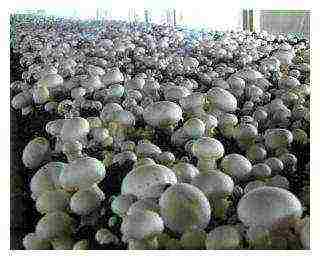
Double-stemmed champignon is the most common type; besides it, two-ring, meadow, and field champignons are grown under artificial conditions. According to the color of the cap, champignons are divided into several groups: white, off-white, cream and brown. The flesh of the cap is whitish, dense, juicy. The leg reaches a height of about 6 cm, it is smooth, cylindrical, tapers towards the base, and has a reddish ring under the cap. In nature, mushrooms grow in forests, orchards and vegetable gardens, where the soil is rich in organic matter. Mushroom picking takes place "in nature" from May to October.
In winter, you can grow mushrooms in adapted cellars, semi-basements and cellars. When it is particularly cold there, stove heating or other heating can be used. A cellar for growing mushrooms is not difficult to arrange. The pit under the cellar is covered with a plank, it is covered with straw, a layer (about 50 cm) of insulation is laid on top, both artificial insulation and ordinary humus can be used. The height of the cellar is about 2 m. It is imperative to equip it with a chimney (make it possible to close the chimney in cold weather) and a groove for water drainage (it is made around the roof). Shelves are placed inside.
As containers for growing, boxes and plastic bags are used, which can be easily removed in case of illness. A substrate based on horse manure is best suited for growing mushrooms; you can also use chicken manure. A less successful, but quite suitable option is the manure of cattle, sheep, goats, pigs, and even human feces. Straw will be an obligatory element in any case. Rotten, rotten brown straw cannot be used. Another component of compost is mineral additives: gypsum, chalk, superphosphate, urea, ammonium nitrate, meat and bone meal. Also, in order to save money, my friends mix wood shavings into the compost, of which they have a decent amount from the time when they built themselves a log house from a bar. They say that the result is the same.
Compost preparation begins by moistening pre-chopped straw. Then the straw is mixed with manure, a high pile is formed and left for a while. The burt can be absolutely any length, but at the same time the width and height cannot be more than 2.5 m. 5-7 days after laying, the temperature inside it reaches a maximum, therefore, in order for the biochemical processes to continue correctly, they make a break.
During the first break, plaster is added and the compost is moistened again. When intermixing, the compost is thoroughly shaken with a fork, breaking up the clods. After 5 days, the pile is again interrupted. In total, 4-5 interruptions are required every 5 days. The substrate is ready 3 days after the last cut. It has a dark brown color, it should not smell of ammonia, it is soft to the touch and tears easily.
The mycelium is added to the compost when its temperature is about 25 degrees. Light is not needed for fruiting, so mushrooms can be grown in complete darkness. It is important that the substrate does not dry out and the temperature does not drop below 20 degrees. Usually, a week after planting the mycelium, its survival rate is checked. To do this, raise the top layer of compost in several places.After that, a casing layer is applied on top (peat, garden soil) and sufficient moisture is maintained (about 80%). Fruiting begins 2-3 weeks after the application of the casing layer. During this period, airing is carried out, but drafts are not allowed. For watering (it is produced after harvesting), warm water is used.
The crops are taken in waves. The first three of them give the maximum amount of mushrooms. For a week from a square meter, you can get up to 6 kg of mushrooms!
After fruiting, the compost can be used as fertilizer for vegetable crops.
Cultivation of champignons video
Mushroom growing: compost and mushroom production
Growing mushrooms
Stewed champignons with sour cream.
This video shows one of the ways to cook mushrooms.
Similar articles
-
Growing quail
The incubation period for quails is 4 days less than that for chickens and is 17 days. At this time, the eggs are placed in a small-sized household incubator such as "Universal" or "Brood hen ..."
-
Pepper Growing Videos
To obtain high indicators of the yield of pepper, it is necessary to follow the sequence of work and take into account the peculiarities of growing the plant from sowing to harvesting and storing the pepper. How…
-
Growing asparagus
It is a herbaceous perennial plant of the lily family with numerous branched stems, reaching 1.5 m in height under favorable conditions. He has reduced to barely noticeable Czech ...
-
Mushroom growing business
Mushroom growing business. People who decide to start growing mushrooms often have the most vague ideas about this. Therefore, novice mushroom growers have a number of questions: is it worth ...
-
Raising pheasants
Raising pheasants. Pheasants are raised in much the same way as chickens. But it should be borne in mind that they are more mobile, shy and more demanding on the temperature regime in the first days. In greenhouse conditions ...
Champignons are a common and fairly common food product for people in advanced economies. The annual consumption of this dietary product here ranges from three to six kilograms per person. Champignons gained such popularity due to their unique chemical composition, which, with regular consumption, has a beneficial effect on all organs and systems of the human body, helps to restore and strengthen immunity.
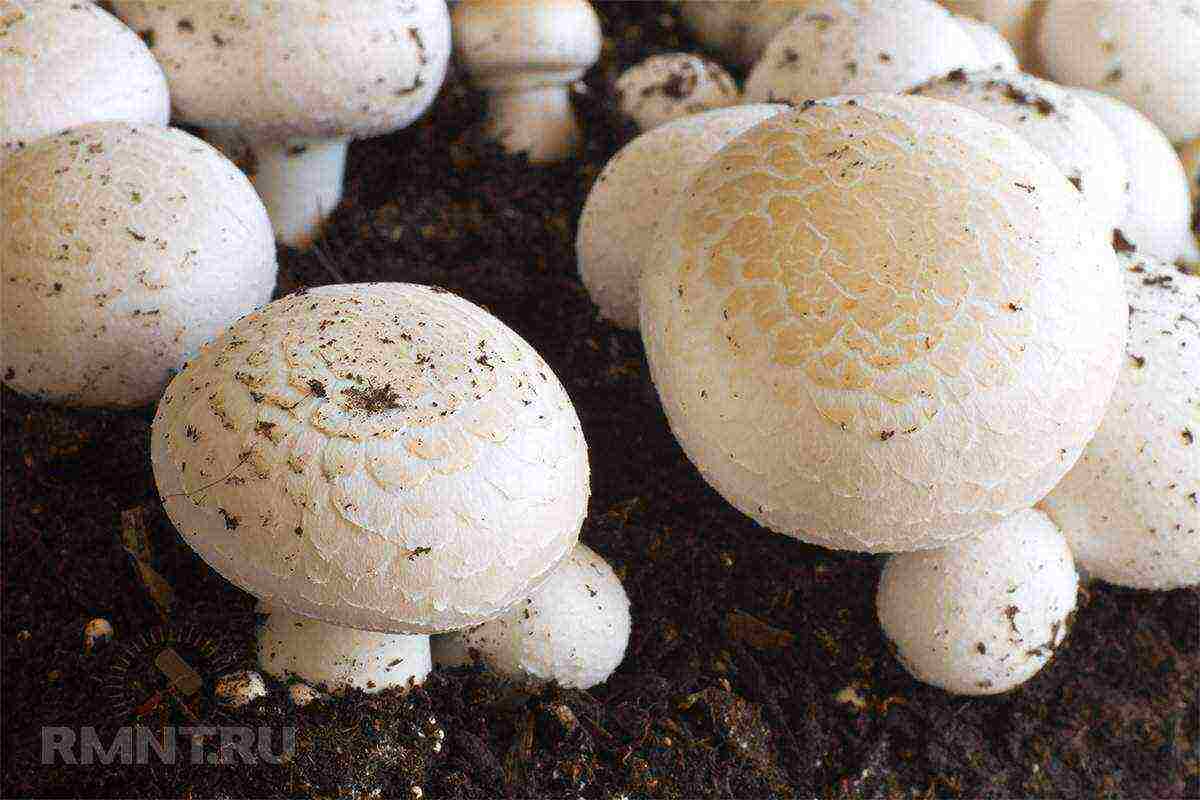
Today, the demand for champignons in the world market is constantly growing, which provides ample opportunities for organizing a business for their cultivation. In the previous article "Growing oyster mushrooms: additional income on your site" we considered the question of how to organize the cultivation of these mushrooms in your backyard. Now let's talk about growing mushrooms.
Today, the industrial cultivation of champignons is developing in two directions - underground and ground mushroom growing.
Underground mushroom farms are sometimes set up in old mines at a depth of 300-600 meters. The temperature at this depth throughout the year fluctuates between 13-17 degrees, and the relative humidity is 85-90%. These indicators are optimal at the stage of mushroom growth. Mine water is used for irrigation on such farms. Underground workings have a microclimate that is ideal for cultivating mushrooms, so there is no need for heating or cooling, no additional effort is required to maintain air humidity. This allows you to significantly reduce the cost of production.
Ground mushroom complexes are a conveyor belt, the production of mushrooms on which also does not depend on the season and external climatic conditions.Such a farm consists of several chambers (from six to twelve), has a special room for the preparation and pasteurization of compost, and is equipped with sophisticated automation to maintain the required microclimate at different stages of cultivation. All work in such a production is mechanized. However, the organization and maintenance of such a complex requires large financial costs.
Some gardeners have learned how to grow mushrooms in their backyards. To do this, they use basements or semi-basements. In areas where the frost-free period lasts more than 6 months, mushrooms are grown in the open field in summer. The success of growing these mushrooms is directly dependent on properly prepared compost.
Making mushroom compost
Horse manure is the most suitable for growing mushrooms, which contains all the necessary elements for the development of the fungus. However, today it is not so easy to find manure from stall horses, so mushroom growers have to find a replacement for it. In the absence of horse manure, it is better to use chicken manure, but if not, then manure from cattle, sheep, goats, pigs and even human feces will be used. Compost, in which, in addition to horse manure, manure from other animals is used, are called semi-synthetic, and if it is prepared without the use of horse manure at all, it is synthetic.
The next essential element of any compost is straw, ideally rye or wheat. You can only use it fresh, with a golden color and a pleasant smell. Straw is a supplier of carbon and nitrogen for champignons.
Mineral additives are considered an obligatory component of high-quality compost. This is, first of all, gypsum, which gives the necessary structure and enriches the compost with calcium. You can also use chalk, urea, superphosphate, ammonium nitrate, meat and bone meal, and other additives. To moisturize all of the above components, you will need water.
There are many composting recipes, depending on the materials available. The classic composition based on horse manure is as follows:
- Fresh horse manure - 2000 kg.
- Straw - 50 kg.
- Urea - 5 kg.
- Ammonium sulfate - 8 kg.
- Superphosphate - 5 kg.
- Chalk - 7.5 kg.
- Alabaster - 30 kg.
Semi-synthetic compost can be prepared according to the following recipe:
- Straw - 500 kg.
- Horse manure - 1000 kg.
- Chicken droppings - 20 kg.
- Urea - 1kg.
- Gypsum - 30 kg.
- Chalk - 1 kg.
Composting is a complex biochemical process that results in the formation of a complex of nutrients that is ideal for the development and growth of the mushroom. To get a good harvest, it is not enough just to mix all these ingredients together. The composting process must be treated with great care.
The area on which maturation will take place must be concreted or asphalted, since in contact with the soil, mushrooms or microorganisms harmful to the champignon can get into the compost.
In the warm season, composting can be done outdoors under a canopy from rains, and for year-round production you will need a room where the air temperature will not drop below 10-12 degrees. In such a room, it is also necessary to provide supply and exhaust ventilation with a capacity of 4–6 air changes per hour.
When organizing a place, it is necessary to take into account that for the preparation of 1 ton of compost, an area of 10-15 square meters will be needed. m. Cooking begins with soaking straw, which is pre-crushed to pieces of 5-7 cm long. Wheat straw within two days can absorb such an amount of water that will be 2.5 times its original weight.After that, straw is mixed with manure and a high pile is formed, the optimal dimensions of which are: width 1.5-2.5 meters, height 2-2.5 meters, the length can be arbitrary. It should be noted that if the amount of straw is less than 100 kg, the required fermentation process may not start.
After laying the pile, due to biochemical processes, the temperature in it rises significantly and reaches a maximum on the 5-7th day. However, humidity, temperature and air conditions in the pile are unevenly distributed. Therefore, in order to continue the fermentation process after seven days, it is necessary to make a break, that is, to move the layers of the pile in places. During interruptions, the compost is thoroughly shaken up, lumps are broken, nutritional supplements are added and, if necessary, moistened.
After 3–5 days, if the pile has warmed up well, the cut is carried out again. Thus, depending on the external conditions and the compost recipe, it may take 5–6 heaps with an interval of 4–5 days. After 3-4 days after the last cutting, the compost is ready. Well cooked, it should be dark brown, free from ammonia, and soft to the touch. In mature compost, the straws should break easily.
For better fermentation and subsequent pasteurization in small farms where there are no special pasteurization chambers, they do this. After the last break, they allow the collar to warm up to a temperature of 60 degrees and do not stir until the smell of ammonia disappears. After the ammonia has evaporated, the compost is cooled to 24-25 degrees, after which inoculation begins, that is, the planting of mycelium.
Mycelium inoculation and growth
The premises in which the mushrooms will be grown must be carefully prepared. Ideally, they should have a concrete floor, well-bleached walls and any other surface. This must be done in order to avoid contamination of the mycelium with harmful fungi and microorganisms, which can significantly reduce the yield. It is necessary to prepare premises for the cultivation of mushrooms in the same way as for the cultivation of oyster mushrooms, which we have already discussed in the previous article.
You can start sowing mycelium when the temperature of the compost after pasteurization drops to a level of 24-25 degrees. Temperatures of 30 degrees and above are dangerous for mushrooms, the spores of the fungus can simply die.
Compost can be used to fill wooden boxes, racks, some use long plastic bags cut along the length. With a ridge height of 20–25 cm, one ton of compost is enough to fill 10 square meters. m of shelving area. The rate of application of mushroom mycelium is 7–8 kg per ton of compost. Thus, for 1 sq. m of area consumed 700-800 grams of mycelium.
Champignon mycelium can be purchased at any specialty store selling garden products and stored in the refrigerator until planting. The day before inoculation, the mycelium is warmed up at room temperature, then crushed in clean dishes and added to the compost. For this, holes 5–8 cm deep are made in the compost already laid out in the boxes in a checkerboard pattern at a distance of 20 cm from each other and pieces of mycelium the size of a walnut are placed in them. After this, the holes are filled up.
To avoid drying out, the seeded mycelium is covered with a layer of newspapers, which are periodically moistened. In this case, it is necessary to carefully monitor that water does not get directly onto the compost. For the same purposes, you can use plastic wrap.
During the growth of the mycelium in the room, it is necessary to maintain the temperature at 24 degrees. Ventilation is carried out only if necessary, since an excess of carbon dioxide has a beneficial effect on the growth of mycelium. The optimum air humidity at this stage is 90–95%. To do this, place containers with water in the room, or simply water the floors.
After a week, check the survival rate of the mycelium. Raise the top layer of compost in several places, if the mycelium has grown 1–2 cm from the place where the seed was applied, then everything is in order. It will take two to three weeks for the mycelium to grow completely. After the mycelium has covered the compost throughout its entire thickness and width, the film and paper are removed and the pre-prepared casing layer is applied. Experts call this process "gobbering".
Gobtirovka
It has long been noted that applying moist soil to mushroom beds promotes better fruit formation. This covering layer has several useful functions:
- retains moisture and protects the compost from drying out;
- stimulates the formation of fruiting bodies;
- regulates the concentration of carbon dioxide and maintains the necessary microclimatic parameters inside the mycelium.
Most often, peat is used as a casing mixture, into which chalk or dolomite chips are added to increase acidity. Peat with chalk is mixed in a ratio of 4: 1 by weight.
The covering mixture should not contain pathogens of champignon diseases, therefore, it is disinfected before being added to the mycelium. The best way to do this is to use water vapor - it is the most reliable and environmentally friendly method. However, in small household farms, it is extremely problematic to use this method of disinfection, therefore they use a formalin solution.
Formalin (40%) is diluted with water 20 times, 12-14 liters of solution is enough to process 1 cubic meter of casing mixture. It is placed on a concrete floor with a layer 20 cm thick and watered with the prepared solution, then covered with polyethylene and left for 2-3 days. At temperatures below 15 degrees, formalin evaporates slowly, which worsens its effect. Therefore, the room temperature must be above this mark.
After 2-3 days, the mixture is shaken and moistened, after which it is applied to the mycelium with a uniform layer of 3-4 cm. Then, as necessary, the mycelium is watered and loosened. For loosening, it is necessary to use a special device resembling a wooden construction trowel, into which metal studs are evenly fixed throughout the entire area (the design is similar to a brush).
Loosening and watering help to improve the structure of the casing layer, create favorable conditions for the development of beneficial microflora, as a result of which the mushroom yield is significantly increased.
The microclimate in the room during the growth of the mycelium after finishing must be maintained at the same level as before, a slight decrease in temperature to 21-22 degrees is allowed. The mycelium fills the surface layer for 7-10 days, after which the rudiments of fruiting bodies begin to form.
Fruiting and harvesting
The full fruiting of the champignon begins 2-3 weeks after finishing. At this time, it is extremely important to lower the temperature in the room to 15-16 degrees, since at a higher temperature, small mushrooms with long legs and with rapidly opening caps will grow. Such goods are poorly stored and transported, and have an unpresentable appearance.
At temperatures below 15 degrees, champignons grow more slowly, and their fruiting period is lengthened. The humidity of the air during the harvest period should be maintained at 80–90%.
The formation of fruiting bodies is accompanied by the release of carbon dioxide in large quantities, therefore it is necessary to provide ventilation with a capacity of 6-8 air volumes per hour. At the same time, drafts and strong air circulation should not be allowed. This can cause the mushroom caps to dry out and crack.
Champignons do not need light during the fruiting period (as in all previous stages of mycelium development), these mushrooms grow well in the dark.Therefore, for harvesting indoors, it is enough to install only emergency lighting. Direct sunlight is extremely harmful to fungi, as it dries out the casing layer and burns the delicate skin on the cap.
Watering must be carried out with warm water (18-25 degrees), watering must be done carefully so as not to get on the surface of the fruit bodies in order to avoid the appearance of spots.
The champignon crop appears in the form of well-defined waves. For several days, the entire surface of the beds is covered with a layer of young mushrooms, then their number decreases, and after a few days they disappear altogether. A new wave of fruiting begins 7–10 days after the end of the previous one.
The maximum amount of harvest (70-80%) is harvested from the first three or four waves, then the number of mushrooms decreases. After each wave, the surface of the mycelium must be cleaned of the remnants of the legs, dead underdeveloped fruiting bodies and other debris. This will save the mycelium from the development of diseases and infection with various harmful microorganisms.
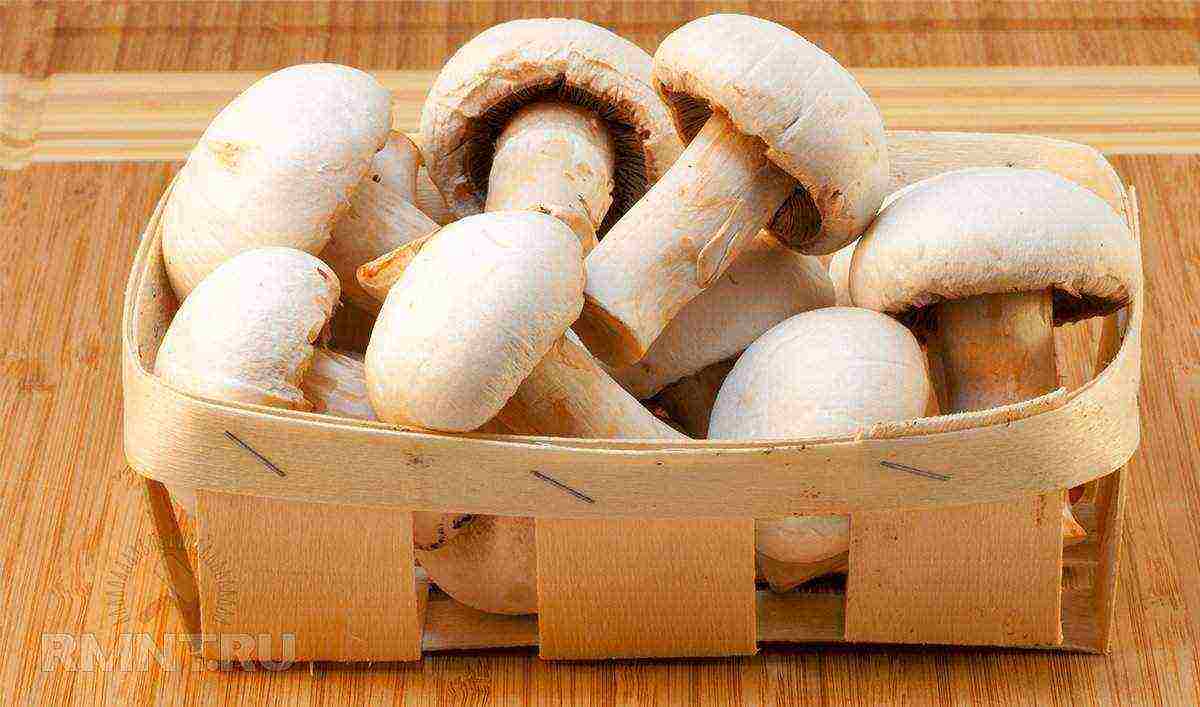
After the end of fruiting, the used compost is removed from the mushroom and taken out to the garden. Here it will be used as a wonderful organic fertilizer or as a mulch. This will help increase fertility and improve the structure of the land on your site. We talked about this in more detail in the article "Organic farming: making the land good."
Before loading new portions of compost into the premises, they must be thoroughly rinsed and disinfected with a formalin solution, and, if necessary, whitewash all surfaces with lime.
Amateur champignon maker in the open air
From all of the above, it is clear that the process of cultivating champignons, to put it mildly, is not easy. In order to study it and try it in action, it is more expedient to start with organizing mushroom beds in the open field.
In the summer, it is necessary to find a shaded area in the garden, build a cover over it, protecting it from overheating and drying out. On the site, the soil needs to be covered with polyethylene or roofing felt, and already on top of it, lay out the compost prepared in advance. Planting mycelium, tacking and other care actions are performed as described in the previous sections. Thus, you will get a mini mushroom bed. Of course, there will not be a large harvest, since it is simply unrealistic to maintain an optimal microclimate here in summer. However, it is quite possible to get a general impression, to master the process of composting and inoculation. And experience, as they say, is worth a lot. Then everyone decides for himself whether it is interesting to do this or not.
Champignons all over the world are considered a dietary high-value food product that contains a large amount of protein, and there is practically no cholesterol. Mushrooms are a low-calorie product, which is especially important when developing various diets to normalize weight and metabolism. Having mastered the technique of growing mushrooms on your personal plot, you can not only provide your family with a valuable food product, but also get the opportunity to have an additional, and in the future may be the main, source of income.
The microclimatic conditions of the cellar are ideal for growing mushrooms. Everyone can buy mycelium and master the technology of growing mushrooms in the basement. If you want to get a good harvest, first of all, you should pay attention to such things as: preparation of the nutrient substrate, equipment of the room, disinfection, temperature and humidity control. Let us examine these and other questions in order.

What should be the cellar?
You can grow mushrooms in any well-made cellar. The floor in the cellar should be concrete, not earthen. In general, the cleaner and more isolated from external influences the room is, the better.
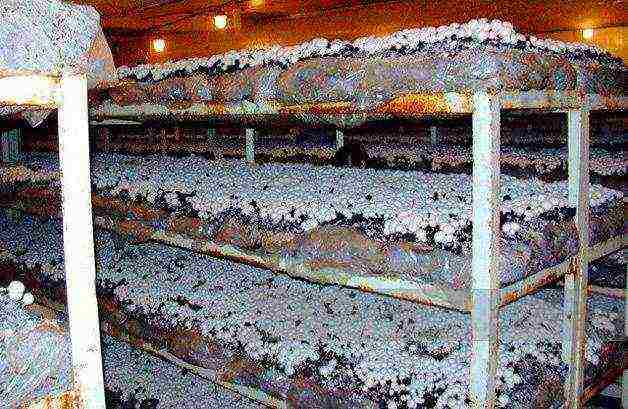
To save space in the basement, racks with mushrooms are equipped with several floors (tiers).
Lighting
Unlike green onions and other plants, mushrooms do not need additional lighting. They can be perfectly grown in the dark. The light should be screwed in only so that it is convenient to work in the cellar or basement.
Ventilation
The cellar should be equipped with a ventilation system, since the compost on which the mushrooms grow actively releases carbon dioxide during decomposition. And mushrooms do not tolerate mustiness. Carbon dioxide must be removed and replaced with fresh air. However, drafts should not be allowed. The ventilation pipes are closed with a fine mesh to prevent insects from getting inside.
If there are not enough conventional supply and exhaust pipes for good ventilation of the cellar. We'll have to take care of the forced ventilation of the room. Additional fans can be used to circulate air above the mushroom boxes. If possible, it is worth installing additional air purification filters.
Temperature and humidity
To control these indicators, install a thermometer and a hygrometer in the mushroom growing room. You can increase the humidity by spraying the racks and the floor with a spray bottle. Reduce - by airing.
The temperature in summer can be regulated by ventilation, but if you plan to grow mushrooms all year round, take care of additional heating of the cellar.
Space zoning
If your cellar is large enough, it makes sense to divide it into two zones. You will use one room for incubation (spreading the mycelium over the substrate), and the second for the direct forcing of mushrooms (fruit bodies). The temperature required for the successful course of these processes is different. The mushroom grows at about 23 degrees, and fruiting occurs at 16-17 degrees.
By maintaining stable temperature conditions in each room, you can simply carry the substrate boxes. In this way, you can grow champignons continuously - while half of the boxes bear fruit, in the other, mycelium grows, and so on. If necessary, add a third composting area.
Pre-disinfection
To grow mushrooms, the basement must be well disinfected, treated from parasites and mold. Champignons are very susceptible to disease and pest infestation, and it will be a shame to lose most of the crop due to neglect of safety measures at the initial stage.
In particular, the following processing can be carried out:
- Fumigate with a sulfuric stick.
- Whitewash the walls and ceiling with lime with the addition of copper sulfate.
- Spray with a 4% formalin solution.
- If there were previously vegetables in the basement, and fruit flies or other pests were bred, you need to treat the room with chlorophos.
- As an additional protective measure, a box of sawdust soaked in a disinfectant solution can be placed at the entrance.
After disinfection, the basement should be thoroughly ventilated, otherwise not only the mushrooms, but also it will be very difficult for you to be inside.
Substrate preparation
The preparation of the nutrient medium on which the mushrooms will grow is one of the most important and crucial moments. To grow the maximum yield, prepare the substrate by following the recommendations on the mycelium packaging you purchased. Since the strains or varieties of champignons are different, the preparation technology and the composition of the substrate may differ insignificantly.

It looks like the substrate on which the mushrooms grow.
However, there are general principles for preparing compost for growing mushrooms, which can be considered universal. The best option would be natural horse manure compost. It is important that the animals eat hay and not green food.
Two options for making natural compost:
| 1 | Horse manure with a high straw content, humidity 40-45% | 850 |
| Urea | 3 | |
| Superphosphate | 13 | |
| Ammonia saltpeter |
8 | |
| Gypsum | 18 | |
| 2 | Horse dung | 2000 |
| Straw | 50 | |
| Urea | 5 | |
| Ammonium sulfate | 8 | |
| Superphosphate | 5 | |
| a piece of chalk | 7,5 | |
| Alabaster |
Horse manure can be replaced with cow or poultry droppings, however, in this case, the yield will be significantly lower.
The straw is soaked for a day in warm water in a convenient trough or other container. After that, it is stacked in a pile mixed with layers of manure. You should get only 6-8 layers. We additionally moisten each layer with warm water. After 3-4 days, the compost should be thoroughly mixed and added with urea and superphosphate. After that, the substrate will acquire a characteristic ammonia smell. After another 3-4 days, the compost is mixed again. So it needs to be shoveled 4-5 times, gradually adding the rest of the minerals. During the last mixing, gypsum is added.
The average compost time is 24–28 days. The completion of the fermentation process can be judged by the disappearance of the ammonia smell and the light brown color of the manure. During the fermentation process, the temperature of the compost can reach 50–70 degrees. For growing mushrooms, the temperature of the compost should be no more than 25 degrees.
It is worth preparing the substrate either in a special utility room with good ventilation, or outdoors under a canopy that protects from rainwater and the sun. We do not pour compost on the ground, it is better to spread cellophane. This is required so that insect pests do not get into the finished substrate.
If it's too difficult for you to prepare your own mushroom substrate, you can always buy it in the store. However, hand-made compost is usually of better quality.
We move the finished substrate to the basement and put it in boxes or containers in which it is planned to grow mushrooms.
Planting mushroom mycelium (inoculation)
So, the substrate is ready and placed in the cellar, now you need to add the mycelium of the fungus to it in order to grow the mycelium. The mycelium is grown industrially in laboratories under sterile conditions. You can buy it at gardening stores or order it online.
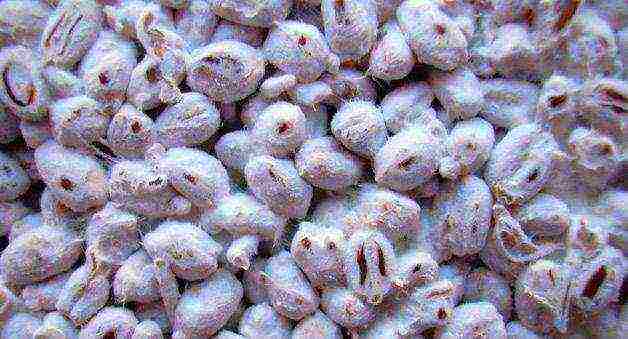
Grain mycelium.
In order to grow mushrooms on 1 square meter of substrate, you need 500 g of compost mycelium or 400 g of champignon cereal spores.
We place the "seeds" in the substrate. If you've composted it correctly, it should bounce slightly when pressed. We make five-centimeter depressions at a distance of 20 centimeters from each other and put a small amount of compost mycelium in each depression. If you have purchased champignon spores, you just need to scatter them over the surface. Gradually, the strings of mycelium will begin to grow over the substrate.
The growth time of the mycelium, while the fruiting bodies of the mushrooms have not yet appeared, is called incubation. During this period, it is necessary to maintain the air humidity in the cellar at 70–95%. To prevent the substrate from drying out, it can be covered with paper or cloth and periodically sprayed with a spray bottle.
The temperature at which mycelium grows is 20–27 degrees. The mushroom filaments will begin to actively spread in ten to twelve days. Then the surface of the substrate should be covered with earth by 3-4 centimeters and wait another 3-5 days. The land is not just from the garden, but a mixture of peat (5 parts), limestone (1 part) and soil (4 parts). Do not forget to sprinkle with water occasionally.
Forcing fruiting bodies
After the incubation period, you should lower the temperature in the cellar to 12-17 degrees, or move the boxes with the substrate to the room for distillation (if, as mentioned at the beginning of the article, you divided the room into two compartments). The period of growth of the mushrooms themselves begins.

For one harvest, 5-8 waves of mushrooms can be removed from the mycelium, although the bulk will fall on the first three waves.
You can remove the first wave of the harvest in 3-4 months. Prevent mushrooms from overripe. You should pick them off when the lower part of the cap is still covered with white film and the brown plates are not visible. Each mushroom must be carefully twisted out of its place, not cut off. From the leg remaining after the cut, bacteria can get into the mycelium.
After collecting the mushroom, the place where it grew should be lightly sprinkled with soil. The champignons will grow vigorously within 1–2 weeks. Under the right conditions and good compost, 5–8 harvests of mushrooms can be harvested during this time. The main volume falls on the first three waves. Then the yield of mycelium will sharply decline.
The best varieties to grow
More than fifty different varieties of champignons are known in the world. Some of them are found in the wild, and some are bred by breeders for industrial breeding.
For growing in a cellar, varieties with high yields, easy to care for and unpretentious are ideal. Among them, two-pore and two-ring can be distinguished. Also suitable for home breeding of meadow mushroom, Somycel 512 and Hauser A15.
The technology for growing champignons in the basement has its own characteristics, but it is not as complicated as it seems at first glance. If you have prepared the right compost, established the required microclimate in the cellar and purchased good planting material, you are guaranteed a high yield of mushrooms! And our recommendations will help you cope with this creative and interesting task.


